The Role of Hydraulic Connectivity and Management on Soil Aggregate Size and Stability in the Clear Creek Watershed, Iowa
Abstract
1. Introduction
2. Materials and Methods
2.1. Site Description
2.2. Flow Pathway Determination and Soil Sampling
2.3. Aggregate Size Distribution
2.4. Aggregate Stability Analysis
2.5. Quantification of Hydraulic Connectivity
2.6. Statistical Analysis
3. Results and Discussion
3.1. Aggregate Size Distribution and Stability
3.2. The Role of Hydraulic Connectivity
3.3. Relationship between Aggregate Size and Stability
3.4. Implications for Upland Erosion Modeling
4. Conclusions
Author Contributions
Funding
Acknowledgments
Conflicts of Interest
References
- Six, J.; Paustian, K.; Elliott, E.T.; Combrink, C. Soil structure and organic matter I. Distribution of aggregate-size classes and aggregate-associated carbon. Soil Sci. Soc. Am. J. 2000, 64, 681–689. [Google Scholar] [CrossRef]
- Zobeck, T.M.; Popham, T.W.; Skidmore, E.L.; Lamb, J.A.; Merrill, S.D.; Lindstrom, M.J.; Mokma, D.L.; Yoder, R.E. Aggregate-mean diameter and wind-erodible soil predictions using dry aggregate-size distributions. Soil Sci. Soc. Am. J. 2003, 67, 425–436. [Google Scholar] [CrossRef]
- Olchin, G.P.; Ogle, S.; Frey, S.D.; Filley, T.R.; Paustian, K.; Six, J. Residue carbon stabilization in soil aggregates of no-till and tillage management of dryland cropping systems. Soil Sci. Soc. Am. J. 2008, 72, 507–513. [Google Scholar] [CrossRef]
- Kara, O.; Baykara, M. Changes in soil microbial biomass and aggregate stability under different land uses in the northeastern Turkey. Environ. Monit. Assess. 2014, 186, 3801–3808. [Google Scholar] [CrossRef] [PubMed]
- Oades, J.M.; Waters, A. Aggregate hierarchy in soils. Soil Res. 1991, 29, 815–828. [Google Scholar] [CrossRef]
- Amezketa, E. Soil aggregate stability: A review. J. Sustain. Agric. 1999, 14, 83–151. [Google Scholar] [CrossRef]
- Castro-Filho, C.; Lourenço, A.; Guimarães, M.D.F.; Fonseca, I.C.B. Aggregate stability under different soil management systems in a red latosol in the state of Parana, Brazil. Soil Tillage Res. 2002, 65, 45–51. [Google Scholar] [CrossRef]
- Beare, M.H.; Hendrix, P.F.; Coleman, D.C. Water-stable aggregates and organic matter fractions in conventional-and no-tillage soils. Soil Sci. Soc. Am. J. 1994, 58, 777–786. [Google Scholar] [CrossRef]
- Franzluebbers, A.J.; Arshad, M.A. Soil microbial biomass and mineralizable carbon of water-stable aggregates. Soil Sci. Soc. Am. J. 1997, 61, 1090–1097. [Google Scholar] [CrossRef]
- Blanco-Canqui, H.; Lal, R. Mechanisms of carbon sequestration in soil aggregates. Crit. Rev. Plant Sci. 2004, 23, 481–504. [Google Scholar] [CrossRef]
- Van Oost, K.; Govers, G.; Desmet, P. Evaluating the effects of changes in landscape structure on soil erosion by water and tillage. Landsc. Ecol. 2000, 15, 577–589. [Google Scholar] [CrossRef]
- Abaci, O.; Papanicolaou, A.N. Long-term effects of management practices on water-driven soil erosion in an intense agricultural sub-watershed: Monitoring and modelling. Hydrol. Process. 2009, 23, 2818–2837. [Google Scholar] [CrossRef]
- Le Bissonnais, Y. Aggregate stability and assessment of soil crustability and erodibility: I. Theory and methodology. Eur. J. Soil Sci. 1996, 47, 425–437. [Google Scholar] [CrossRef]
- Karim, T.; Qadir, K.; Aziz, S. Rate of soil aggregates disintegration as affected by type and rate of manure application and water quality. Int. J. Plan. Anim. Environ. Sci. 2013, 3, 94–102. [Google Scholar]
- Li, Z.; Yang, W.; Cai, C.; Wang, J. Aggregate mechanical stability and relationship with aggregate breakdown under simulated rainfall. Soil Sci. 2013, 178, 369–377. [Google Scholar] [CrossRef]
- Farres, P.J. Some observations on the stability of soil aggregates to raindrop impact. Catena 1980, 7, 223–231. [Google Scholar] [CrossRef]
- Loch, R.J.; Foley, J.L. Measurement of aggregate breakdown under rain—Comparison with tests of water stability and relationships with field measurements of infiltration. Soil Res. 1994, 32, 701–720. [Google Scholar] [CrossRef]
- Bryan, R.B. Soil erodibility and processes of water erosion on hillslope. Geomorphology 2000, 32, 385–415. [Google Scholar] [CrossRef]
- Papanicolaou, A.N.; Wacha, K.M.; Abban, B.K.; Wilson, C.G.; Hatfield, J.; Stanier, C.; Filley, T.R. From soilscapes to landscapes: A landscape-oriented approach to simulate soil organic carbon dynamics in intensively managed landscapes. J. Geophys. Res. Biogeosci. 2015, 120, 2375–2401. [Google Scholar] [CrossRef]
- Sidorchuk, A.; Schmidt, J.; Cooper, G. Variability of shallow overland flow velocity and soil aggregate transport observed with digital videography. Hydrol. Process. 2008, 22, 4035–4048. [Google Scholar] [CrossRef]
- Wang, J.; Yu, B.; Yang, W.; Cheng, J.; Song, Y.; Cai, C. The abrasion of soil aggregate under different artificial rough beds in overland flow. Catena 2017, 155, 183–190. [Google Scholar] [CrossRef]
- Skidmore, E.L.; Powers, D.H. Dry soil-aggregate stability: Energy-based index. Soil Sci. Soc. Am. J. 1982, 46, 1274–1279. [Google Scholar] [CrossRef]
- Perfect, E.; Kay, B.D.; Ferguson, J.A.; Da Silva, A.P.; Denholm, K.A. Comparison of functions for characterizing the dry aggregate size distribution of tilled soil. Soil Tillage Res. 1993, 28, 123–139. [Google Scholar] [CrossRef]
- Ciric, V.; Manojlovic, M.; Nesic, L.; Belic, M. Soil dry aggregate size distribution: Effects of soil type and land use. J. Soil Sci. Plant Nutr. 2012, 12, 689–703. [Google Scholar] [CrossRef]
- Stott, D.E.; Karlen, D.L.; Cambardella, C.A.; Harmel, R.D. A soil quality and metabolic activity assessment after fifty-seven years of agricultural management. Soil Sci. Soc. Am. J. 2013, 77, 903–913. [Google Scholar] [CrossRef]
- Wang, Y.; Zhang, J.H.; Zhang, Z.H. Influences of intensive tillage on water-stable aggregate distribution on a steep hillslope. Soil Tillage Res. 2015, 151, 82–92. [Google Scholar] [CrossRef]
- Robinson, D.O.; Page, J.B. Soil aggregate stability. Soil Sci. Soc. Am. J. 1951, 15, 25–29. [Google Scholar] [CrossRef]
- Marquez, C.O.; Garcia, V.J.; Cambardella, C.A.; Schultz, R.C.; Isenhart, T.M. Aggregate-size stability distribution and soil stability. Soil Sci. Soc. Am. J. 2004, 68, 725–735. [Google Scholar] [CrossRef]
- De Gryze, S.; Six, J.; Merckx, R. Quantifying water-stable soil aggregate turnover and its implication for soil organic matter dynamics in a model study. Eur. J. Soil Sci. 2006, 57, 693–707. [Google Scholar] [CrossRef]
- Chaplot, V.; Cooper, M. Soil aggregate stability to predict organic carbon outputs from soils. Geoderma 2015, 243, 205–213. [Google Scholar] [CrossRef]
- Hou, T.; Berry, T.D.; Singh, S.; Hughes, M.N.; Tong, Y.; Papanicolaou, A.T.; Wacha, K.M.; Wilson, C.G.; Chaubey, I.; Filley, T.R. Control of tillage disturbance on the chemistry and proportion of raindrop-liberated particles from soil aggregates. Geoderma 2018, 330, 19–29. [Google Scholar] [CrossRef]
- Moebius, B.N.; van Es, H.M.; Schindelbeck, R.R.; Idowu, O.J.; Clune, D.J.; Thies, J.E. Evaluation of laboratory-measured soil properties as indicators of soil physical quality. Soil Sci. 2007, 172, 895–912. [Google Scholar] [CrossRef]
- Hole, F.D. An approach to landscape analysis with emphasis on soils. Geoderma 1978, 21, 1–23. [Google Scholar] [CrossRef]
- Schmidt, K.; Behrens, T.; Friedrich, K.; Scholten, T. A method to generate soilscapes from soil maps. J. Plant Nutr. Soil Sci. 2010, 173, 163–172. [Google Scholar] [CrossRef]
- Okin, G.S.; Heras, M.M.D.L.; Saco, P.M.; Throop, H.L.; Vivoni, E.R.; Parsons, A.J.; Wainwright, J.; Peters, D.P. Connectivity in dryland landscapes: Shifting concepts of spatial interactions. Front. Ecol. Environ. 2015, 13, 20–27. [Google Scholar] [CrossRef]
- Mueller, E.N.; Wainwright, J.; Parsons, A.J. Impact of connectivity on the modeling of overland flow within semiarid shrubland environments. Water Resour. Res. 2007, 43. [Google Scholar] [CrossRef]
- Lexartza-Artza, I.; Wainwright, J. Hydrological connectivity: Linking concepts with practical implications. Catena 2009, 79, 146–152. [Google Scholar] [CrossRef]
- Cavalli, M.; Trevisani, S.; Comiti, F.; Marchi, L. Geomorphometric assessment of spatial sediment connectivity in small Alpine catchments. Geomorphology 2013, 188, 31–41. [Google Scholar] [CrossRef]
- Parsons, A.J.; Bracken, L.; Poeppl, R.E.; Wainwright, J.; Keesstra, S.D. Introduction to special issue on connectivity in water and sediment dynamics. Earth Surf. Process. Landf. 2015, 40, 1275–1277. [Google Scholar] [CrossRef]
- Coulthard, T.J.; Van De Wiel, M.J. Modelling long term basin scale sediment connectivity, driven by spatial land use changes. Geomorphology 2017, 277, 265–281. [Google Scholar] [CrossRef]
- Poeppl, R.E.; Keesstra, S.D.; Maroulis, J. A conceptual connectivity framework for understanding geomorphic change in human-impacted fluvial systems. Geomorphology 2017, 277, 237–250. [Google Scholar] [CrossRef]
- Wohl, E.; Magilligan, F.J.; Rathburn, S.L. Introduction to the special issue: Connectivity in geomorphology. Geomorphology 2017, 277, 1–5. [Google Scholar] [CrossRef]
- Crema, S.; Cavalli, M. SedInConnect: A stand-alone, free and open source tool for the assessment of sediment connectivity. Comput. Geosci. 2018, 111, 39–45. [Google Scholar] [CrossRef]
- Famiglietti, J.S.; Rudnicki, J.W.; Rodell, M. Variability in surface moisture along a hillslope transect: Rattlesnake Hill, Texas. J. Hydrol. 1998, 210, 259–281. [Google Scholar] [CrossRef]
- Le Bissonnais, Y.; Cros-Cayot, S.; Gascuel-Odoux, C. Topographic dependence of aggregate stability, overland flow and sediment transport. Agronomie 2002, 22, 489–501. [Google Scholar] [CrossRef]
- Kuhn, N.J.; Hoffmann, T.; Schwanghart, W.; Dotterweich, M. Agricultural soil erosion and global carbon cycle: Controversy over? Earth Surf. Process. Landf. 2009, 34, 1033–1038. [Google Scholar] [CrossRef]
- Stavi, I.; Lal, R. Variability of soil physical quality in uneroded, eroded, and depositional cropland sites. Geomorphology 2011, 125, 85–91. [Google Scholar] [CrossRef]
- Abban, B.K.; Papanicolaou, A.N.; Cowles, M.K.; Wilson, C.G.; Abaci, O.; Wacha, K.M.; Schilling, K.E.; Schnoebelen, D. An enhanced Bayesian fingerprinting framework for studying sediment source dynamics in intensively managed landscapes. Water Resour. Res. 2016, 52, 4646–4673. [Google Scholar] [CrossRef]
- Papanicolaou, A.N.; Abban, B.K.; Dermisis, D.C.; Giannopoulos, C.P.; Flanagan, D.C.; Frankenberger, J.R.; Wacha, K.M. Flow resistance interactions on hillslopes with heterogeneous attributes: Effects on runoff hydrograph characteristics. Water Resour. Res. 2018, 54, 359–380. [Google Scholar] [CrossRef]
- Natural Resources Conservation Service (NRCS). Soil Tillage Intensity Rating; US Department of Agriculture: Washington, DC, USA, 2008.
- Tayfur, G.; Kavvas, M.L. Areally-averagei overland flow equations at hillslope scale. Hydrol. Sci. J. 1998, 43, 361–378. [Google Scholar] [CrossRef]
- Cochrane, T.A.; Flanagan, D.C. Assessing water erosion in small watersheds using WEPP with GIS and digital elevation models. J. Soil Water Conserv. 1999, 54, 678–685. [Google Scholar]
- Wilson, C.G.; Papanicolaou, A.N.; Abban, B.K.; Keefer, L.; Wacha, K.M.; Dermisis, D.; Giannopoulos, C.P.; Zhou, S.; Goodwell, A.; Woo, D.; et al. The Intensively Managed Landscape Critical Zone Observatory: A scientific testbed for understanding critical zone processes in agroecosystems. Vadose Zone J. 2018. [Google Scholar] [CrossRef]
- Iowa Environmental Mesonet. Available online: https://mesonet.agron.iastate.edu/ (accessed on 5 August 2017).
- Ruhe, R.V. Quaternary Landscapes in Iowa, 1st ed.; Iowa State University Press: Ames, IA, USA, 1969. [Google Scholar]
- Bettis, E.A.; Muhs, D.R.; Roberts, H.M.; Wintle, A.G. Last glacial loess in the conterminous U.S.A. Quat. Sci. Rev. 2003, 22, 1907–1946. [Google Scholar] [CrossRef]
- USDA-NRCS. National Agronomy Manual. 190-V-NAM, 3rd ed.; USDA: Washington, DC, USA, 2002.
- Wilson, C.G.; Wacha, K.M.; Papanicolaou, A.N.; Sander, H.A.; Freudenberg, V.B.; Abban, B.K.; Zhao, C. Assessing sustainability of current management practices in an intensively managed landscape. J. Contemp. Water Res. Educ. 2016, 158, 148–171. [Google Scholar] [CrossRef]
- Gee, G.W.; Bauder, J.W. Particle-size analysis. In Methods of Soil Analysis 1: Physical and Mineralogical Methods, 2nd ed.; Klute, A., Ed.; American Society of Agronomy: Madison, WI, USA, 1986; pp. 383–411. [Google Scholar]
- Staff, S.S.L. Soil survey laboratory methods manual. In Soil Survey Investigations Report; United States Department of Agriculture Natural Resources Conservation Service: Lincoln, NE, USA, 2004. [Google Scholar]
- Miller, R.O.; Kissel, D.E. Comparison of soil pH methods on soils of North America. Soil Sci. Soc. Am. J. 2010, 74, 310–316. [Google Scholar] [CrossRef]
- ArcGIS, version 10.1; Environmental Systems Research Institute (ESRI): Redlands, CA, USA, 2012.
- Iowa Geodata. Available online: https://geodata.iowa.gov/ (accessed on 2 February 2017).
- Jenson, S.K.; Domingue, J.O. Extracting topographic structure from digital elevation data for geographic information system analysis. Photogramm. Eng. Remote Sens. 1988, 54, 1593–1600. [Google Scholar]
- Pansu, M.; Gautheyrou, J.; Loyer, J.-Y. Soil Analysis, 1st ed.; A. A. Balkema Publishers: Lisse, The Netherlands, 2001. [Google Scholar]
- Day, P.R. Particle fractionation and particle-size analysis. In Methods of Soil Analysis. Part 1; American Society of Agronomy Inc.: Madison, WI, USA, 1965; pp. 545–567. [Google Scholar]
- Borja, K.; Mercado, J.; Combatt, E. Methods of mechanical dispersion for determining granulometric fractions in soils using four dispersant solutions. Agron. Colomb. 2015, 33, 253–260. [Google Scholar] [CrossRef]
- Hillel, D. Introduction to Environmental Soil Physics, 1st ed.; Elsevier: Amsterdam, The Netherlands, 2004. [Google Scholar]
- Yang, X.M.; Wander, M.M. Temporal changes in dry aggregate size and stability: Tillage and crop effects on a silty loam Mollisol in Illinois. Soil Tillage Res. 1998, 49, 173–183. [Google Scholar] [CrossRef]
- Haynes, R.J. Effect of sample pretreatment on aggregate stability measured by wet sieving or turbidimetry on soils of different cropping history. J. Soil Sci. 1993, 44, 261–270. [Google Scholar] [CrossRef]
- Hu, Y.; Fister, W.; Kuhn, N.J. Temporal variation of SOC enrichment from interrill erosion over prolonged rainfall simulations. Agriculture 2013, 3, 726–740. [Google Scholar] [CrossRef]
- Norton, L.D.; Savabi, R. Evolution of a linear variable intensity rainfall simulator for surface hydrology and erosion studies. Appl. Eng. Agric. 2010, 26, 239–245. [Google Scholar] [CrossRef]
- Elhakeem, M.; Papanicolaou, A.N. Estimation of the runoff curve number via direct rainfall simulator measurements in the state of Iowa, USA. Water Resour. Manag. 2009, 23, 2455–2473. [Google Scholar] [CrossRef]
- Marshall, J.S.; Palmer, W.M.K. The distribution of raindrops with size. J. Meteorol. 1948, 5, 165–166. [Google Scholar] [CrossRef]
- Iowa Department of Transportation Drainage Manual, Ames, IA. Available online: https://iowadot.gov/design/design-manual (accessed on 5 January 2010).
- Lehrsch, G.A.; Kincaid, D.C. Sprinkler droplet energy effects on soil penetration resistance and aggregate stability and size distribution. Soil Sci. 2006, 171, 435–447. [Google Scholar] [CrossRef]
- Fu, Y.; Li, G.L.; Zheng, T.H.; Li, B.Q.; Zhang, T. Splash detachment and transport of loess aggregate fragments by raindrop action. Catena 2017, 150, 154–160. [Google Scholar] [CrossRef]
- Atlas, D.; Srivastava, R.C.; Sekhon, R.S. Doppler radar characteristics of precipitation at vertical incidence. Rev. Geophys. 1973, 11, 1–35. [Google Scholar] [CrossRef]
- Beguería, S.; Angulo-Martínez, M.; Gaspar, L.; Navas, A. Detachment of soil organic carbon by rainfall splash: Experimental assessment on three agricultural soils of Spain. Geoderma 2015, 245, 21–30. [Google Scholar] [CrossRef]
- Kathiravelu, G.; Lucke, T.; Nichols, P. Rain drop measurement techniques: A review. Water 2016, 8, 29. [Google Scholar] [CrossRef]
- Papanicolaou, A.N.; Abaci, O. Upland erosion modeling in a semihumid environment via the Water Erosion Prediction Project model. J. Irrig Drain. Eng. 2008, 134, 796–806. [Google Scholar] [CrossRef]
- Dermisis, D.; Abaci, O.; Papanicolaou, A.N.; Wilson, C.G. Evaluating grassed waterway efficiency in southeastern Iowa using WEPP. Soil Use Manag. 2010, 26, 183–192. [Google Scholar] [CrossRef]
- Black, K.; Tolhurst, T.J.; Paterson, D.M.; Hagerthey, S.E. Working with natural cohesive sediments. J. Hydraul. Eng. 2002, 128, 2–8. [Google Scholar] [CrossRef]
- Partheniades, E. Cohesive Sediments in Open Channels: Erosion, Transport and Deposition, 1st ed.; Butterworth-Heinmann: Oxford, UK, 2009. [Google Scholar]
- Papanicolaou, A.N.; Sanford, J.T.; Dermisis, D.C.; Mancilla, G.A. A 1-D morphodynamic model for rill erosion. Water Resour. Res. 2010, 46, W09541. [Google Scholar] [CrossRef]
- Alberts, E.E.; Nearing, M.A.; Weltz, M.A.; Risse, L.M.; Pierson, F.B.; Zhang, X.C.; Laflen, J.M.; Simanton, J.R. Chapter 7-Soil component. In USDA-Water Erosion Prediction Project: Hillslope Profile and Watershed Model Documentation, NSERL Report No. 10; Flanagan, D.C., Nearing, M.A., Eds.; USDA National Erosion Research Laboratory: West Lafayette, IN, USA, 1995. [Google Scholar]
- Legout, C.; Leguedois, S.; Le Bissonnais, Y. Aggregate breakdown dynamics under rainfall compared with aggregate stability measurements. Eur. J. Soil Sci. 2005, 56, 225–237. [Google Scholar] [CrossRef]
- Abban, B.; Papanicolaou, A.N.; Giannopoulos, C.P.; Dermisis, D.C.; Wacha, K.M.; Wilson, C.G.; Elhakeem, M. Quantification of change in soil surface roughness at the raindrop detachment zone as a function of rainfall intensity under flatbed preconditions. Nonlinear Process. Geophys. 2017, 24, 569–579. [Google Scholar] [CrossRef]
- Maxwell, A.R.; Papanicolaou, A.N. Step-pool morphology in high-gradient streams. Int. J. Sediment Res. 2001, 16, 380–390. [Google Scholar]
- Horn, R. Aggregate characterization as compared to soil bulk properties. Soil Tillage Res. 1990, 17, 265–289. [Google Scholar] [CrossRef]
- Dal Ferro, N.; Sartori, L.; Simonetti, G.; Berti, A.; Morari, F. Soil macro-and microstructure as affected by different tillage systems and their effects on maize root growth. Soil Tillage Res. 2014, 140, 55–65. [Google Scholar] [CrossRef]
- Nath, A.J.; Lal, R. Effects of tillage practices and land use management on soil aggregates and soil organic carbon in the north Appalachian region, USA. Pedosphere 2017, 27, 172–176. [Google Scholar] [CrossRef]
- Elliott, E.T.; Cambardella, C.A. Physical separation of soil organic matter. Agric. Ecosyst. Environ. 1991, 34, 407–419. [Google Scholar] [CrossRef]
- Bossuyt, H.; Six, J.; Hendrix, P.F. Aggregate-protected carbon in no-tillage and conventional tillage agroecosystems using carbon-14 labeled plant residue. Soil Sci. Soc. Am. J. 2002, 66, 1965–1973. [Google Scholar] [CrossRef]
- Pierson, F.B.; Mulla, D.J. Aggregate stability in the Palouse region of Washington: Effect of landscape position. Soil Sci. Soc. Am. J. 1990, 54, 1407–1412. [Google Scholar] [CrossRef]
- Hoyos, N.; Comerford, N.B. Land use and landscape effects on aggregate stability and total carbon of Andisols from the Colombian Andes. Geoderma 2005, 129, 268–278. [Google Scholar] [CrossRef]
- Sidorchuk, A. Stochastic modeling of erosion and deposition in cohesive soils. Hydrol. Process. 2005, 19, 1399–1417. [Google Scholar] [CrossRef]
- De Roo, A.P.J.; Wesseling, C.G.; Ritsema, C.J. LISEM: A single-event physically based hydrological and soil erosion model for drainage basins. I: Theory, input and output. Hydrol. Process. 1996, 10, 1107–1117. [Google Scholar] [CrossRef]
- Laloy, E.; Bielders, C.L. Modelling intercrop management impact on runoff and erosion in a continuous maize cropping system: Part I. Model description, global sensitivity analysis and Bayesian estimation of parameter identifiability. Eur. J. Soil Sci. 2009, 60, 1005–1021. [Google Scholar] [CrossRef]
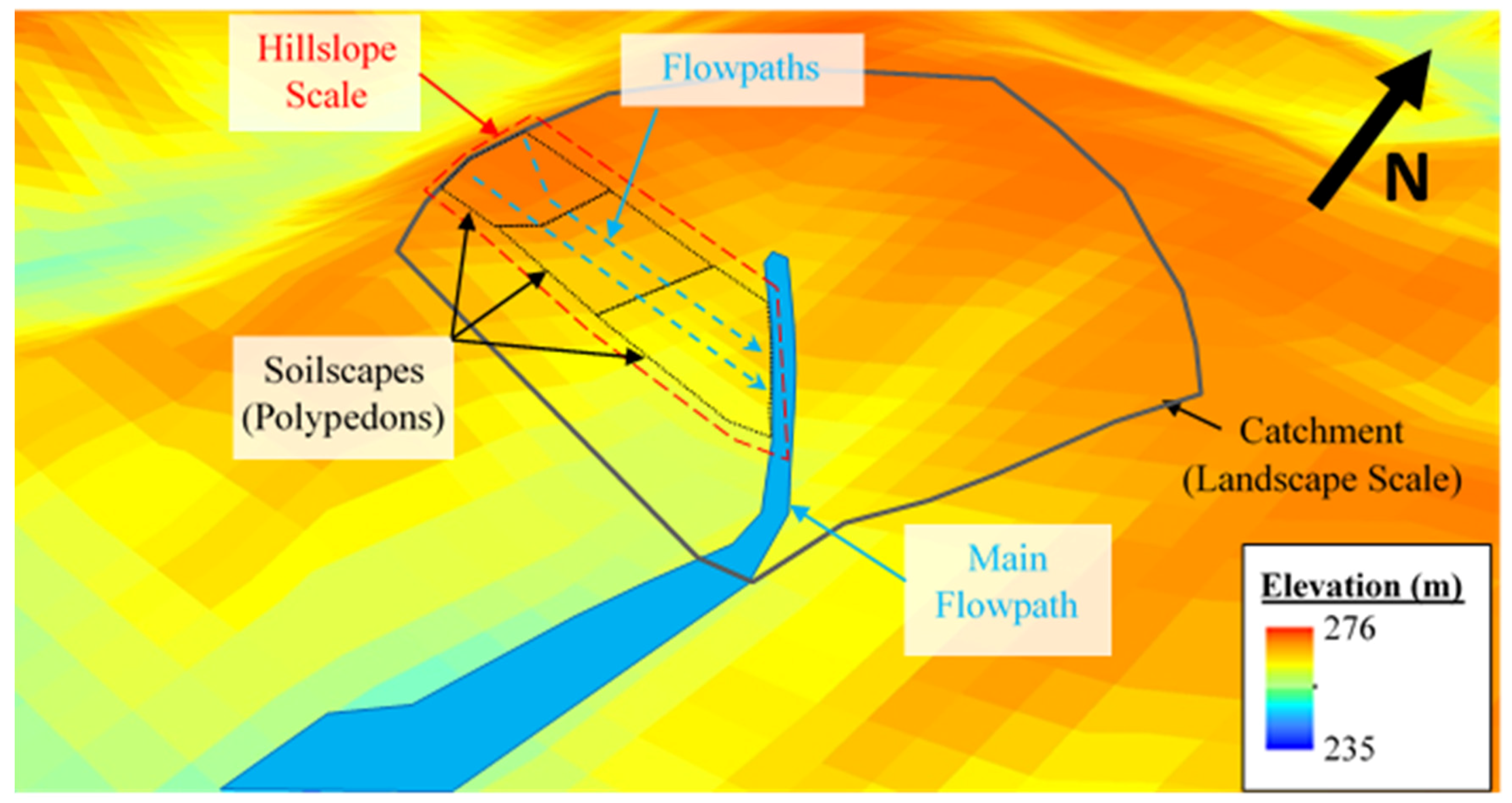
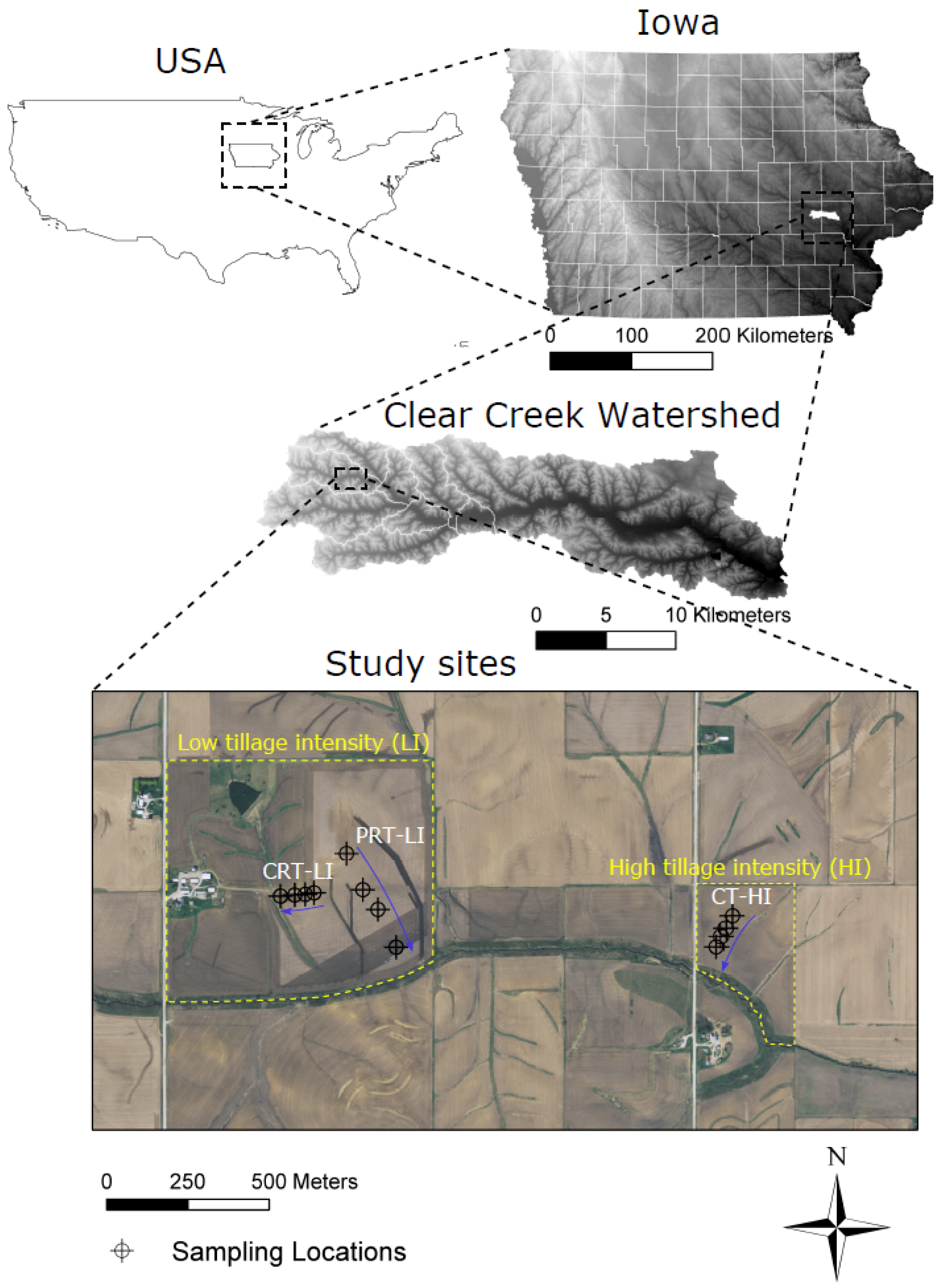
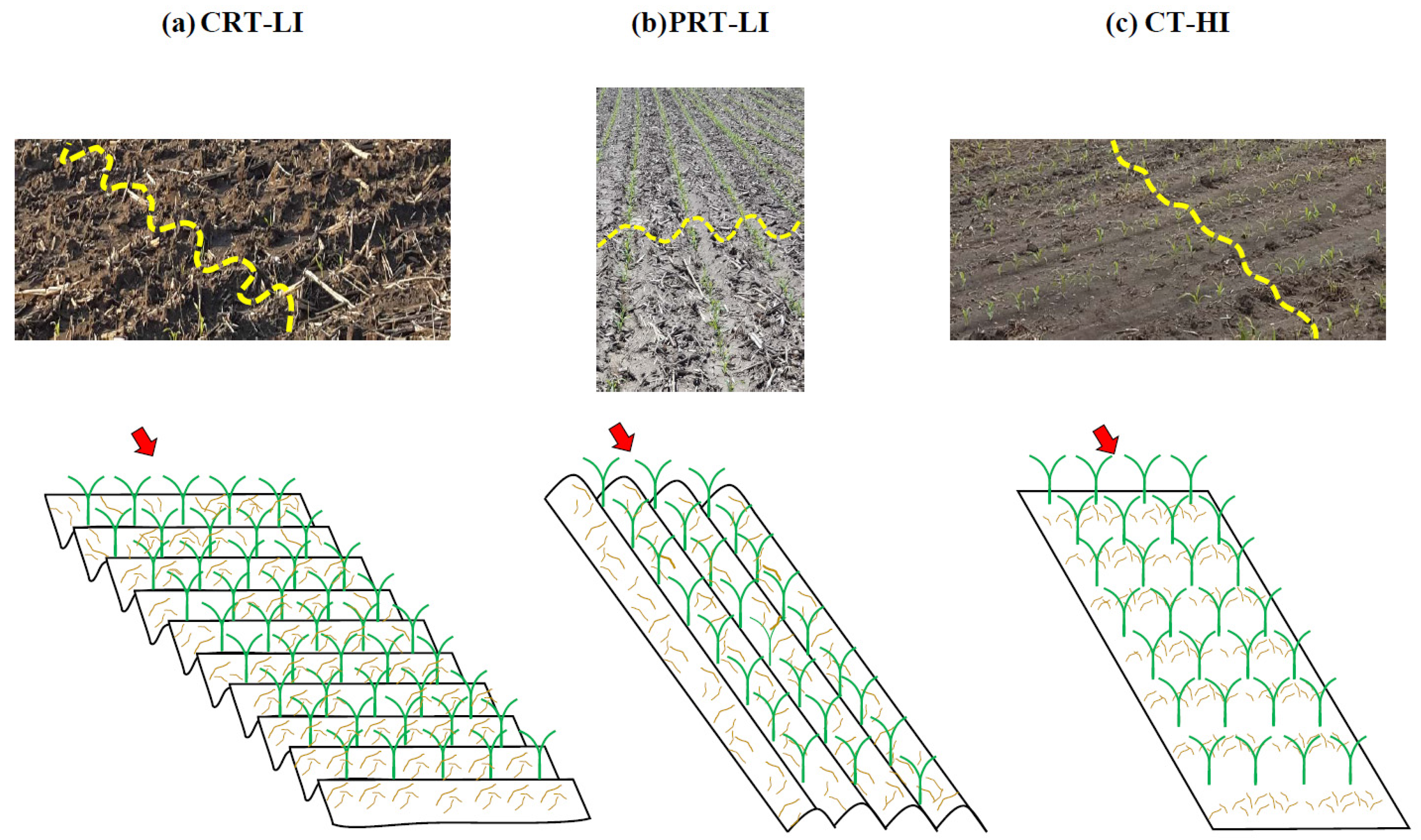
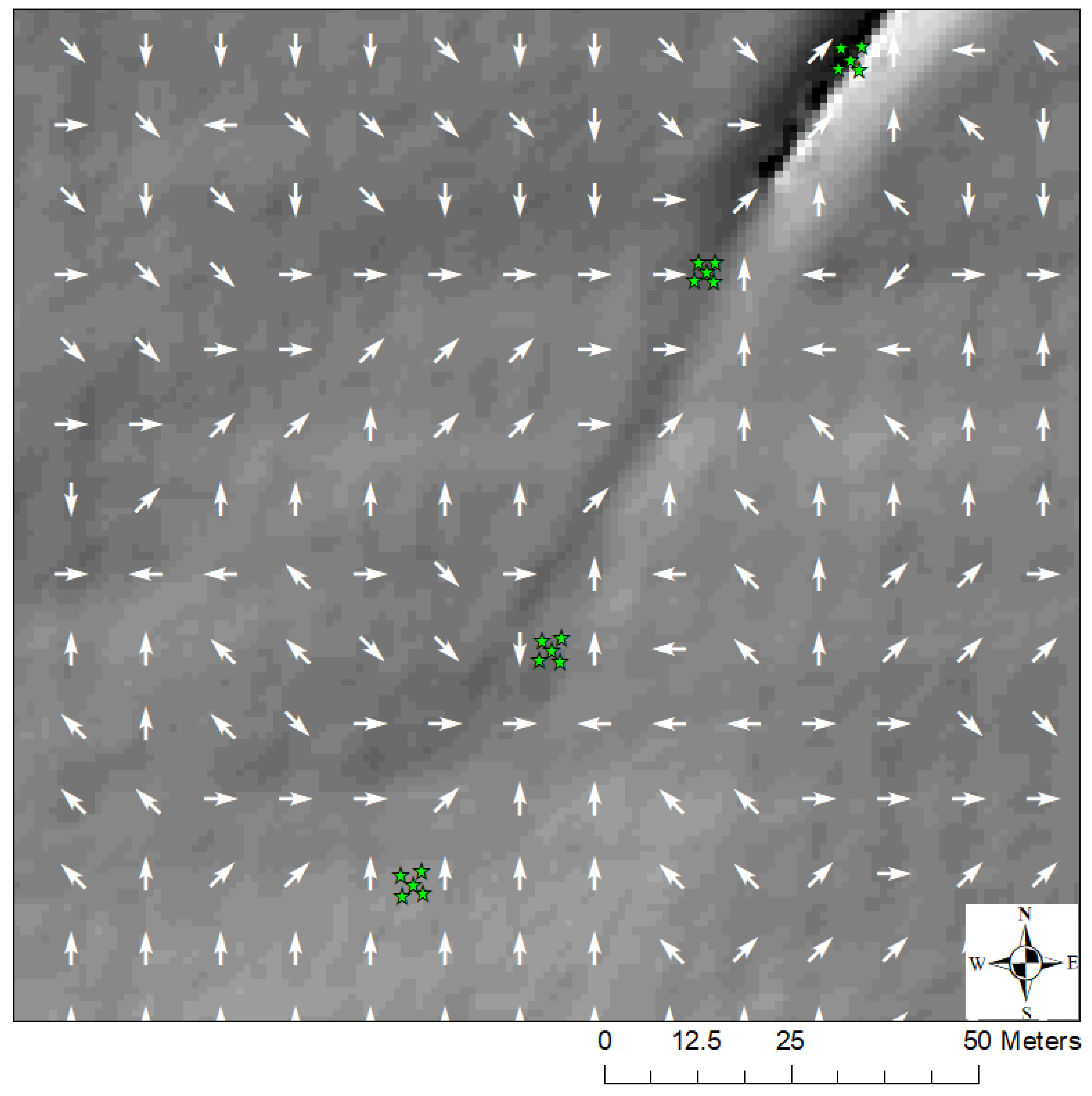
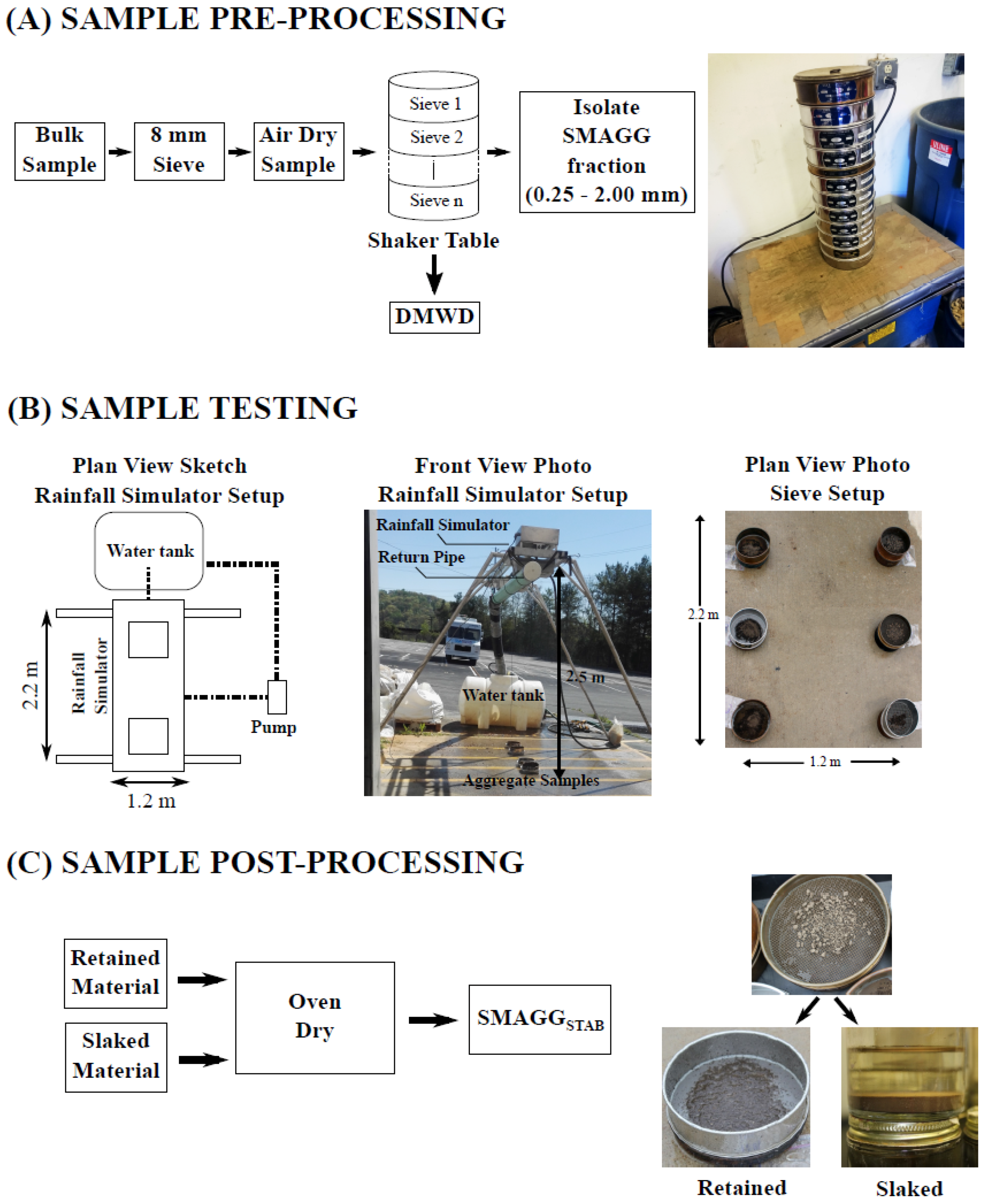
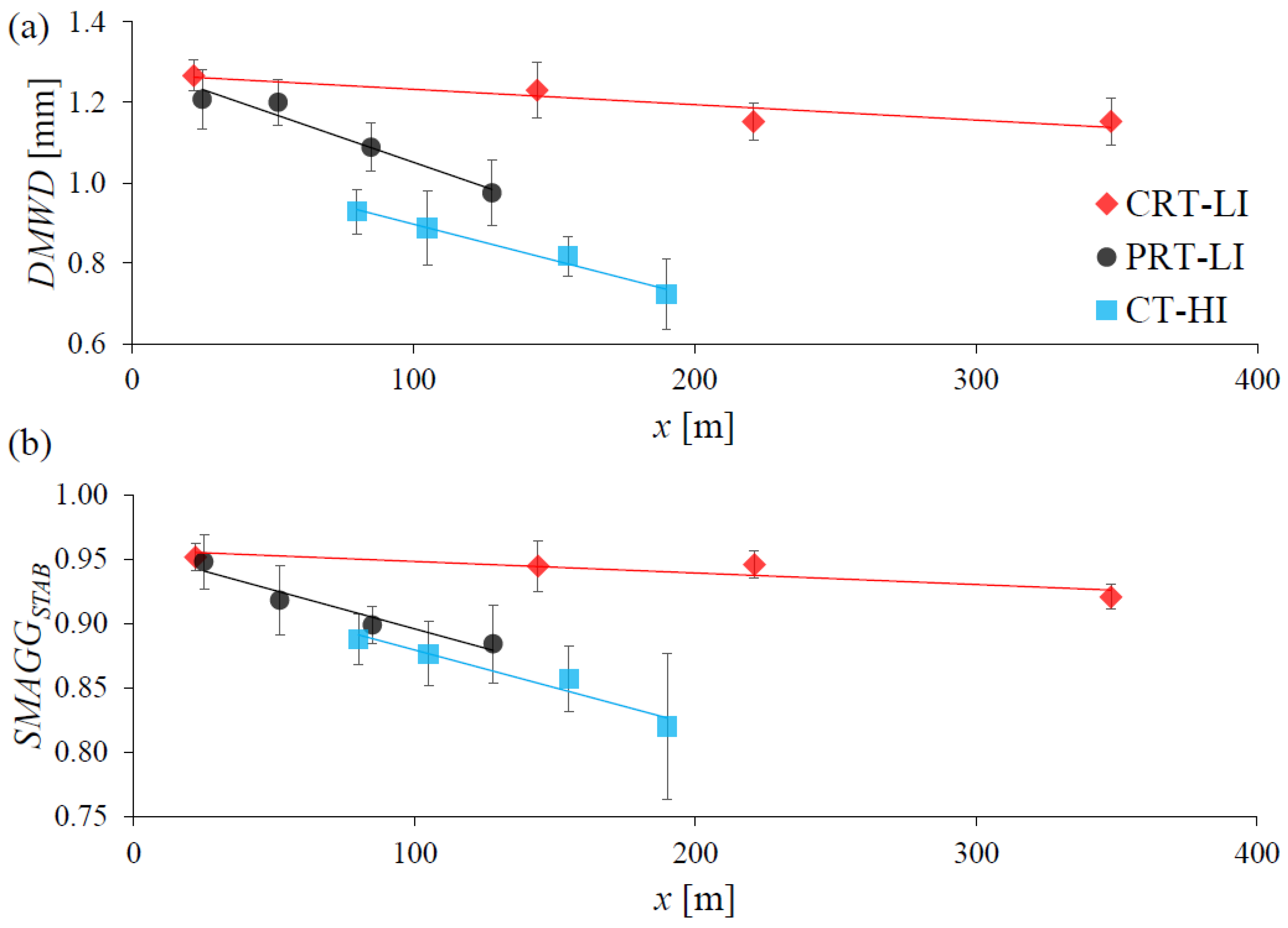
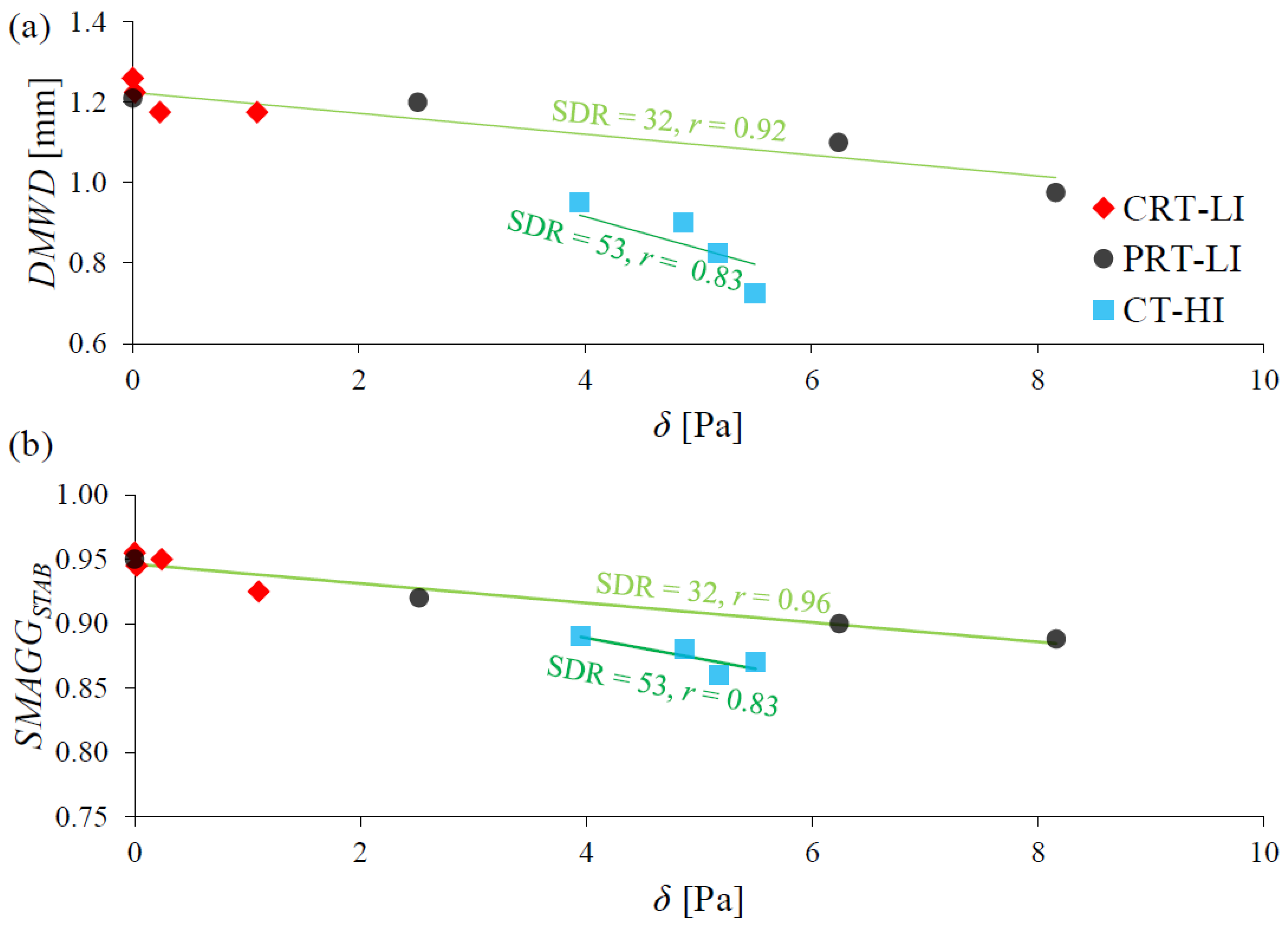

| Site | Soil Texture (%) a | Bulk Density (g cm−3) b | Soil Organic Carbon (%) c | pH d | Flowpath Length (m) | Slope (%) | ||
|---|---|---|---|---|---|---|---|---|
| Sand | Silt | Clay | ||||||
| Contour Ridge Tillage-Low Intensity (CRT-LI) | 1.9 | 71.0 | 27.1 | 0.95 | 2.0 | 6.0 | 450 | 6.5 |
| Parallel Ridge Tillage-Low Intensity (PRT-LI) | 3.4 | 71.0 | 23.6 | 1.04 | 1.9 | 6.6 | 150 | 8.4 |
| Contour Tillage-High Intensity (CT-HI) | 4.1 | 69.5 | 26.4 | 0.95 | 2.0 | 6.2 | 225 | 5.7 |
| Management | Landscape Position * | DMWD (mm) | SMAGGSTAB | ||
|---|---|---|---|---|---|
| Mean | Std Dev | Mean | Std Dev | ||
| Contour Ridge Tillage-Low Intensity (CRT-LI) | 1 | 1.266 | 0.08 | 0.952 | 0.021 |
| 2 | 1.231 | 0.16 | 0.945 | 0.045 | |
| 3 | 1.152 | 0.10 | 0.946 | 0.024 | |
| 4 | 1.153 | 0.13 | 0.921 | 0.022 | |
| Parallel Ridge Tillage-Low Intensity (PRT-LI) | 1 | 1.208 | 0.17 | 0.948 | 0.048 |
| 2 | 1.200 | 0.13 | 0.918 | 0.060 | |
| 3 | 1.088 | 0.13 | 0.899 | 0.033 | |
| 4 | 0.975 | 0.18 | 0.885 | 0.068 | |
| Contour Tillage-High Intensity (CT-HI) | 1 | 0.928 | 0.12 | 0.888 | 0.044 |
| 2 | 0.887 | 0.21 | 0.877 | 0.056 | |
| 3 | 0.818 | 0.11 | 0.857 | 0.057 | |
| 4 | 0.722 | 0.19 | 0.820 | 0.127 | |
© 2018 by the authors. Licensee MDPI, Basel, Switzerland. This article is an open access article distributed under the terms and conditions of the Creative Commons Attribution (CC BY) license (http://creativecommons.org/licenses/by/4.0/).
Share and Cite
Wacha, K.M.; Papanicolaou, A.N.T.; Giannopoulos, C.P.; Abban, B.K.; Wilson, C.G.; Zhou, S.; Hatfield, J.L.; Filley, T.R.; Hou, T. The Role of Hydraulic Connectivity and Management on Soil Aggregate Size and Stability in the Clear Creek Watershed, Iowa. Geosciences 2018, 8, 470. https://doi.org/10.3390/geosciences8120470
Wacha KM, Papanicolaou ANT, Giannopoulos CP, Abban BK, Wilson CG, Zhou S, Hatfield JL, Filley TR, Hou T. The Role of Hydraulic Connectivity and Management on Soil Aggregate Size and Stability in the Clear Creek Watershed, Iowa. Geosciences. 2018; 8(12):470. https://doi.org/10.3390/geosciences8120470
Chicago/Turabian StyleWacha, Kenneth M., A. N. Thanos Papanicolaou, Christos P. Giannopoulos, Benjamin K. Abban, Christopher G. Wilson, Shengnan Zhou, Jerry L. Hatfield, Timothy R. Filley, and Tingyu Hou. 2018. "The Role of Hydraulic Connectivity and Management on Soil Aggregate Size and Stability in the Clear Creek Watershed, Iowa" Geosciences 8, no. 12: 470. https://doi.org/10.3390/geosciences8120470
APA StyleWacha, K. M., Papanicolaou, A. N. T., Giannopoulos, C. P., Abban, B. K., Wilson, C. G., Zhou, S., Hatfield, J. L., Filley, T. R., & Hou, T. (2018). The Role of Hydraulic Connectivity and Management on Soil Aggregate Size and Stability in the Clear Creek Watershed, Iowa. Geosciences, 8(12), 470. https://doi.org/10.3390/geosciences8120470





